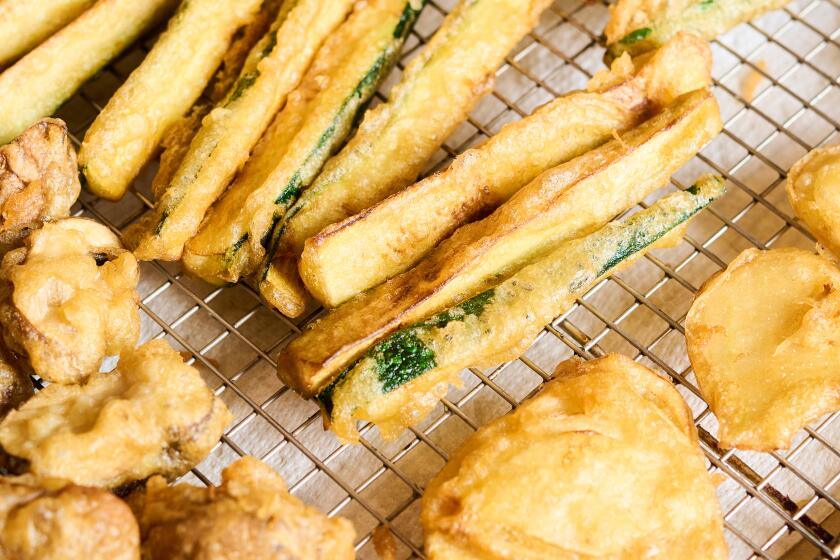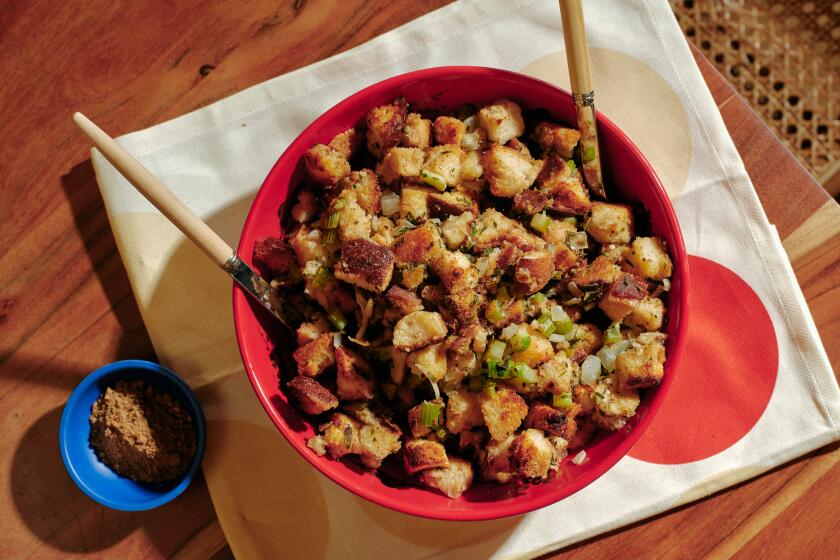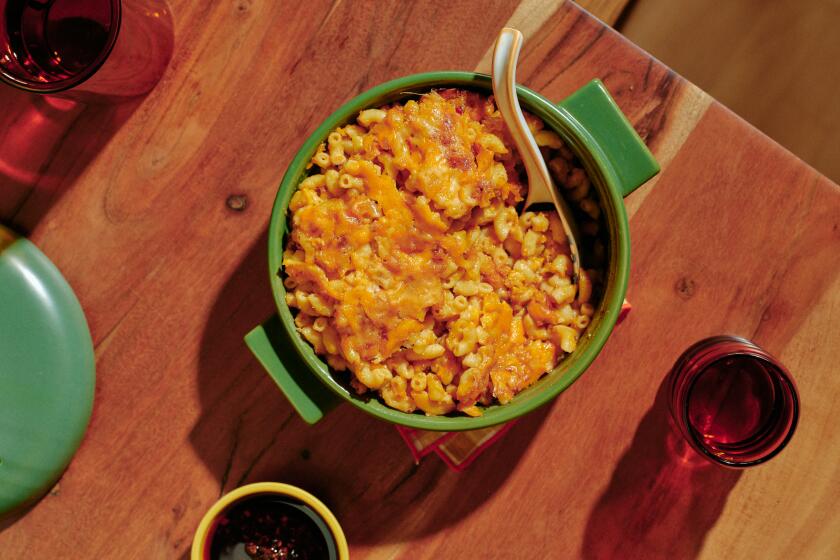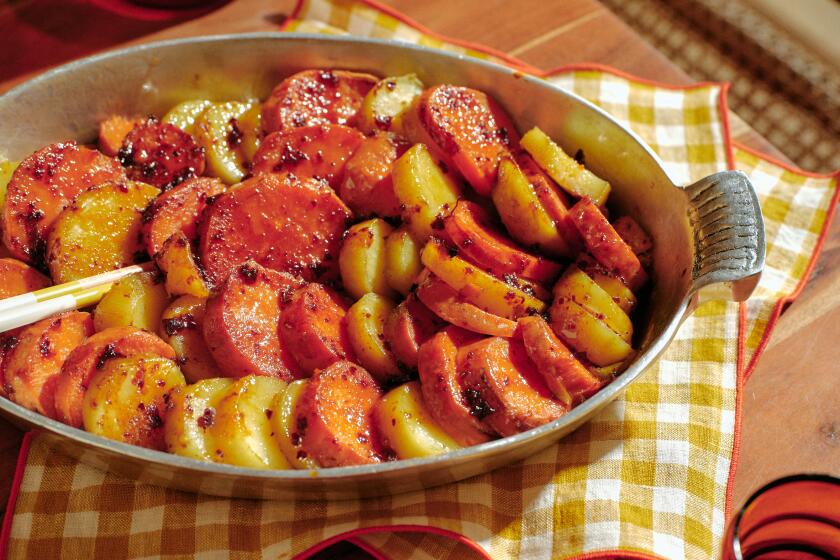Braised chestnuts with fennel and onions
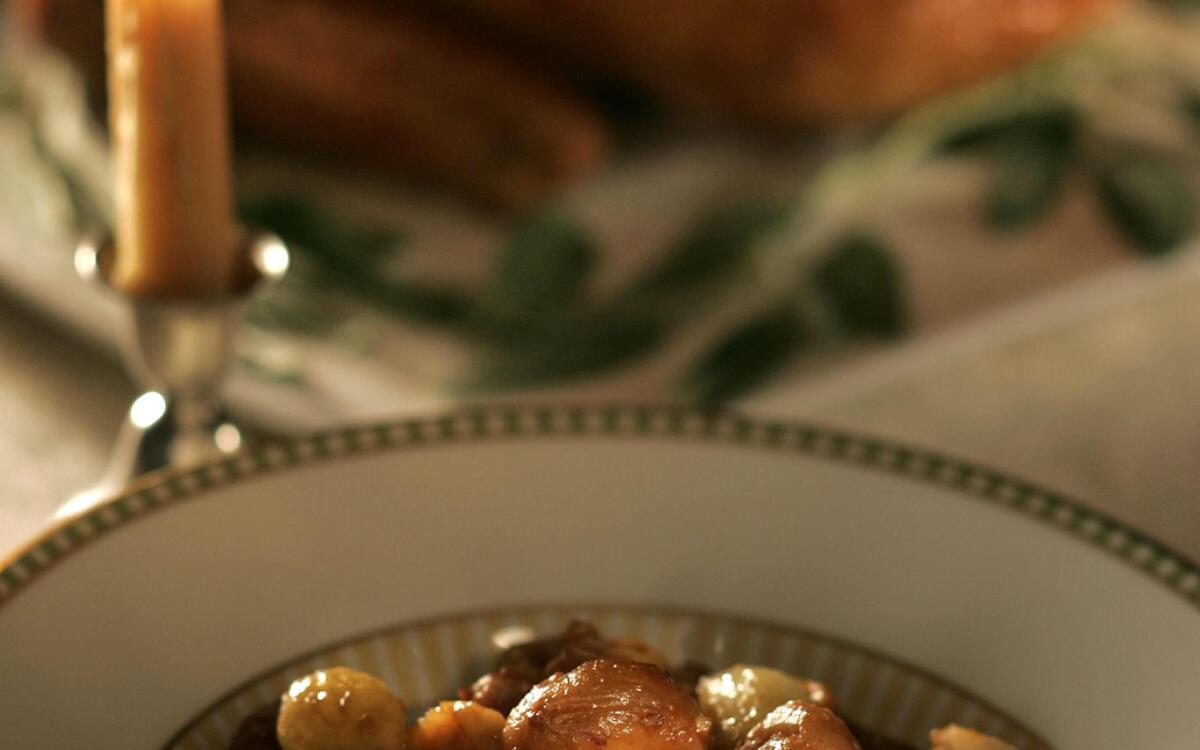
FOOD is almost religion to the French, but never more so than at the holidays. One of the most alluring traditions from a country that invented foie gras and perfected chocolate is reveillon, the late-night feast on Dec. 24, the early-morning feast on Dec. 25 and, for good measure, the anytime feast on New Yearâs Eve or Day.
Reveillon originated as the celebratory meal after midnight mass in a heavily Catholic country, but everything about it is made for multicultural modern America.
The whole focus is on luxury and indulgence.
A typical meal starts with plenty of caviar or oysters or foie gras (or all three), proceeds through some variation on turkey or goose, and winds up with a buche de Noel, the cake decorated to look like the yule log. Depending on the region or the players, the menu can be expanded to include smoked salmon or lobster to begin and no fewer than 13 desserts to end.
âReveillon de Noel is to France what Thanksgiving is to America,â said Ariane Daguin, who owns the foie gras and game purveyor DâArtagnan.
âOnce a year you get the family togetherâ and eat almost to excess. Reveillon on New Yearâs Eve, she added, is when the French feast with friends.
Every family has its own version of the traditional menu.
For instance, Joel Robuchon, the renowned chef who has restaurants in Paris, Tokyo, Macao and Monaco and has recently opened in Las Vegas, says what will come out of his home kitchen in Paris includes caviar and smoked salmon, classic lobster a lâamericaine, roast chicken with foie gras and truffles, and a refreshing salad of oranges, dates and nuts perfumed with orange flower water and garnished with mint.
*
Chefs celebrate
YOU wonât see reveillon mentioned on the menu at many French restaurants in Los Angeles, but tradition drives the Christmas Eve choices nonetheless.
Ortolan is offering a gussied-up variation on the typical lineup, including scallop ceviche; celeri remoulade and duck crisp; oysters; langoustines in ravioli with black truffles; lobster gratinee with ginger; capon with foie gras and truffles; and, of course, la buche.
La Cachette also will serve the cake log, but after venison, duck or cod.
âWe celebrate at the restaurant, not at home, because weâre working,â said Jean Francois Meteigner, La Cachetteâs chef-owner. And just like in France, Christmas Eve will involve more families with children, while New Yearâs Eve will be more couples and groups of friends, he said.
Ortolanâs executive chef-owner, Christophe Eme, waits for his feast until Christmas or the day after, when the restaurant is closed and he can have friends and some staff to his home. This year he intends to do a menu that includes venison, fish and the requisite buche de Noel.
âWe have some Champagne, we play cards,â he said. His family in France always served seven or eight courses, starting with oysters and salmon and moving on to fish and a turkey or goose.
Daguin, who this year will be feeding her parents (her father is a renowned Gascon chef), said she starts with oysters, chicken sausage with truffles, some type of âbig bird,â a side dish of chestnuts, a green vegetable, a big salad and a chunk of cheese such as Roquefort.
Turkey, goose or capon are all good candidates for the bird because they have enough meat to feed a large group, she added, but the main course can also be a ham or roast.
âBy popular re-demand,â she said, she stuffs the bird under the skin with truffle butter before roasting it, to flavor and perfume the flesh.
Chestnuts are often used as stuffing for reveillon birds, because they soak up the cooking juice so well. But Daguin, over the years, has made a recipe from Robuchonâs âSimply Frenchâ cookbook her own: to his confit of chestnuts with pearl onions and fennel she adds a hefty dose of garlic, and substitutes demi-glace for chicken stock for braising, which creates a far more intense flavor.
Easily the most essential ingredient in reveillon is the buche de Noel, the classic roulade swathed in chocolate icing. Larousse Gastronomique says it was created sometime after 1870 to replicate the log traditionally burned in the fireplace at Christmastime.
Too often the buche starts with an airy roulade and is more about the frosting than the cake. But the one created by Michelle Myers, chef-owner of Boule and pastry chef at Sona in West Hollywood, is a flourless chocolate cake with an amazing texture, velvety with a very fine, tender crumb, and with an apricot filling.
The intense flavor comes from dark chocolate with at least 60% cacao, such as Valrhona Caraibe (66%).
*
A dozen more desserts
FOR all the popularity of the buche, it is not always a solo performer. Marrons glaces -- glazed chestnuts -- are almost as important to the holiday as the buche; a box of the fancy confections are just the thing to tuck under your arm on the way to a reveillon dinner.
On the Daguin table, the buche will be joined by a dozen more desserts.
âMy grandmother was from St.-Remy, and in Provence, they have 13 desserts,â she said. âItâs a religious thing,â symbolizing Jesus and his apostles at the Last Supper.
Her selection can include choices as simple as clementines, dates, figs or a bowl of almonds, or as store-bought-fancy as French macaroons and good chocolates, or the Provencal confections called calissons, made from almonds and candied fruit.
Since reveillon originated in the land of the health paradox, wine figures prominently in any celebration. Daguin said her table always has Champagne with the appetizers, then white wine, then red and finally more Champagne with dessert.
What makes reveillon worth emulating in this country is that it is as much about smart shopping as it is about cooking.
Foie gras, raw oysters, caviar and chestnuts are all a matter of picking and unpacking. The right big bird, stuffed with truffle butter, does not even need a sauce. And no stigma is ever attached to a buche de Noel from a good bakery.
Bring a large pot of water to a rolling boil. As it heats, cut an X into the flat side of each chestnut. Add about 1 tablespoon of salt to the water, then add the chestnuts. Boil until tender, about 20 to 24 minutes. Cool, then remove the shells and inner skins. Set aside.
Tie the thyme, parsley and celery leaves together with kitchen twine. Set aside.
Melt 4 tablespoons butter in a large, deep skillet over medium heat. Add the garlic and cook just until aromatic, 1 minute, then add the chestnuts and stir until they are coated with butter. Cook 5 to 10 minutes, stirring often, until they are golden. Stir in the demi-glace and one-half cup water. Lay the tied-together herbs on top of the chestnuts. Lower the heat and simmer, stirring occasionally, until the chestnuts are almost soft and the liquid is reduced to a glaze, about 15 to 20 minutes.
While the chestnuts cook, cook the onions. Trim the stem end and cut a small cross into the base of each onion. Blanch in boiling salted water for 2 minutes. Drain well, then peel. Combine the remaining tablespoon of butter with the sugar in a small saucepan. Add the onions and cook, stirring, until they are glazed, about 2 minutes. Cover the pan tightly and cook until the onions are tender, about 15 minutes. Shake the pan occasionally to keep the onions from burning.
Cut the fennel bulb into julienne strips about 1 1/2 inches long and chop the fronds coarsely. Stir the strips into the onions and cook, stirring, until softened, about 5 minutes.
When the chestnuts are cooked, remove and discard the herb bundle. Stir in the onion mixture. Season with salt and pepper to taste. Just before serving, stir in the fennel fronds, adding some as a garnish.
Get our Cooking newsletter.
Your roundup of inspiring recipes and kitchen tricks.
You may occasionally receive promotional content from the Los Angeles Times.












